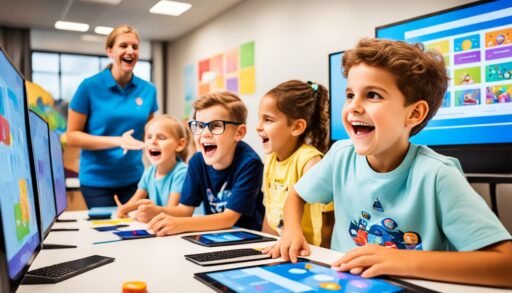Online education has revolutionized the way children learn and grow. With the advent of virtual learning, kids now have access to a wide range of e-learning resources, educational websites, and online classes tailored to their needs. This digital learning landscape offers a plethora of benefits, from flexibility to accessibility, that traditional education may not always provide.
Today, we will delve deeper into the world of online education for kids and explore its various advantages. From virtual classrooms to personalized learning platforms, we’ll uncover how these digital tools can enhance your child’s educational journey.
Key Takeaways:
- Online education for kids offers flexibility and convenience.
- E-learning resources and educational websites cater to individual learning needs.
- Virtual classrooms and personalized learning platforms provide engaging and effective educational experiences.
- Parental involvement and support play a significant role in maximizing the benefits of online education.
- Minimizing online risks and fostering digital literacy skills are essential for a balanced online learning environment.
What is eLearning?
eLearning, also known as online learning or virtual learning, refers to any form of learning that takes place through digital platforms and the internet. This educational approach allows children to access learning materials and resources online and engage in virtual classrooms from the comfort of their own homes. eLearning offers students the opportunity to learn at their own pace and provides flexibility in terms of when and where they learn.
Online education allows children to tailor their learning experiences to their individual needs and preferences. They can choose to study specific subjects, explore new interests, or delve deeper into topics they find fascinating. With eLearning, children have the freedom to learn at their own pace, pausing and revisiting content as needed. This flexibility empowers students to take ownership of their education and fosters self-driven learning.
In addition to flexibility, eLearning promotes the development of digital skills. In today’s increasingly digital world, proficiency in technology is essential. By engaging in online education, children gain experience using digital tools, navigating online platforms, and honing their digital literacy skills. These skills are not only vital for their academic success but also for future career prospects.
Overall, eLearning offers a dynamic and interactive learning environment that adapts to the needs of each learner. By harnessing the power of technology, online education opens up a world of possibilities, expanding access to educational resources and fostering a love for lifelong learning.
Benefits of eLearning:
- Flexible learning schedules
- Access to a wide range of educational resources
- Personalized learning experiences
- Development of digital skills
- Opportunity to learn at their own pace
The Benefits of eLearning for Kids
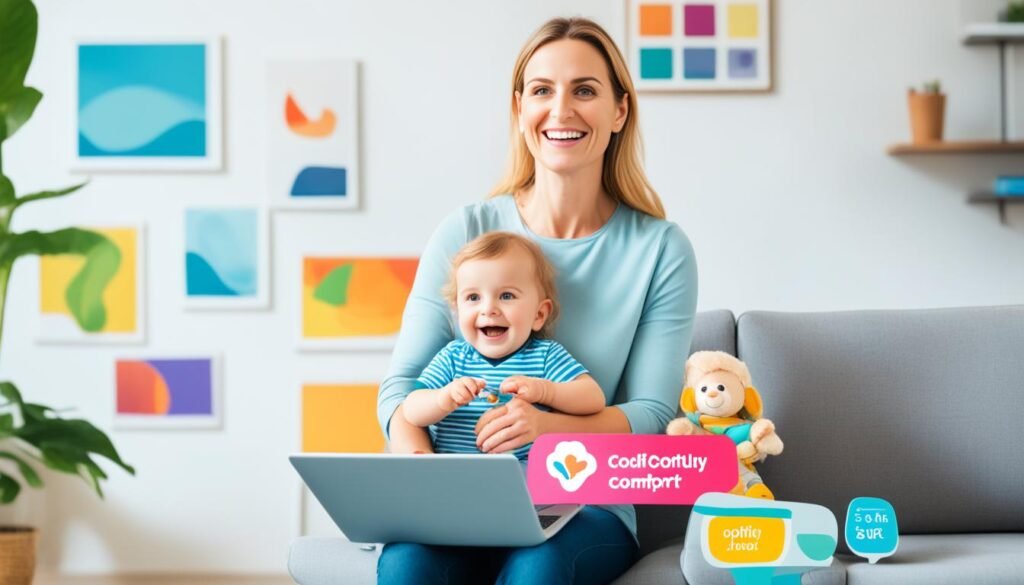
Online education for kids offers numerous benefits that make it an ideal choice for parents and children alike. Let’s explore the advantages of eLearning:
Cost-Effective
eLearning is a cost-effective option for parents as it eliminates the need to invest in additional resources such as textbooks and transportation. Online courses are often more affordable than traditional classroom-based education, making it a budget-friendly choice for families.
Time-Saving
With eLearning, children can save valuable time that would otherwise be spent commuting to and from school. They can access their lessons and learning materials at any time, allowing for a more efficient use of their time. This flexibility is especially beneficial for children with busy schedules or extracurricular activities.
Flexible Learning
eLearning offers flexibility in terms of where and when children can learn. Whether it’s early morning or late at night, children can access their online courses and continue their education at their own pace. This flexibility accommodates different learning styles and allows children to tailor their learning experience to their individual needs.
Accessible
eLearning is accessible to children from any location with an internet connection. This accessibility means that children in remote areas or those facing physical limitations can still access quality education. It also provides a convenient option for working parents, who can ensure their children’s education while balancing their professional responsibilities.
Convenient for Working Parents
One of the key advantages of eLearning for kids is its convenience for working parents. Online education allows parents to incorporate their children’s learning into their busy work schedules. They can easily supervise their children’s progress, provide support, and engage in their education without the need for additional commutes or time-consuming activities.
Through eLearning, children can enjoy a cost-effective, time-saving, flexible, and accessible education that suits their needs and the demands of their parents’ busy lives.
How to Create Effective Online Learning for Kids
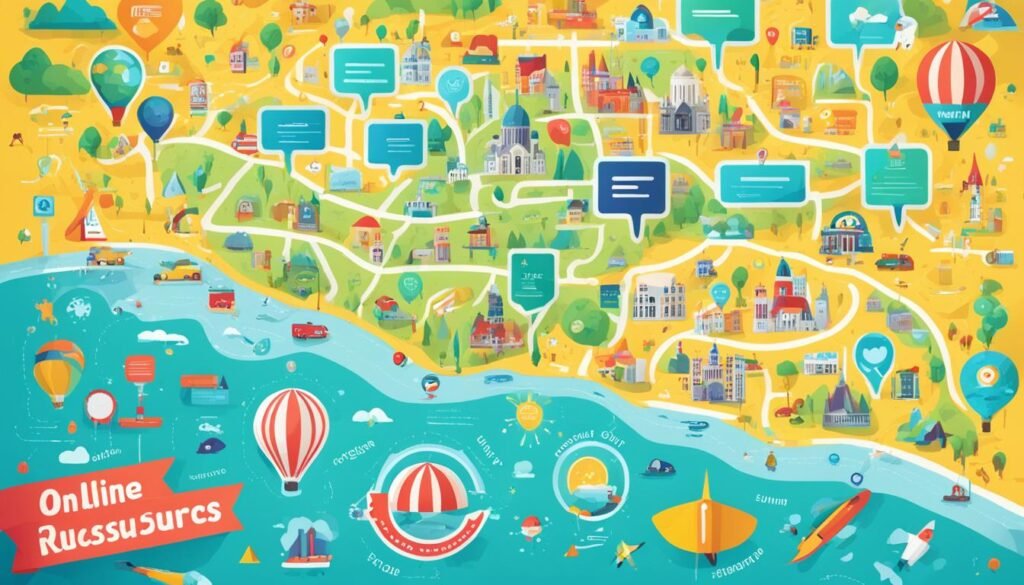
Designing online courses that effectively engage and educate children requires careful consideration of their individual learning styles. By understanding how children absorb information, educators can tailor their online content to enhance the learning experience and maximize its impact.
Visual and Interactive Content
Visuals play a crucial role in capturing children’s attention and facilitating comprehension. Incorporating images, infographics, and diagrams can help simplify complex concepts and make learning more enjoyable. Additionally, interactive elements such as quizzes, games, and simulations provide hands-on experiences that foster active participation and deeper understanding.
“The use of visual and interactive content in online courses can significantly enhance children’s learning experience. It engages their senses, sparks curiosity, and encourages exploration.”
Videos
Children are naturally drawn to videos and multimedia content, making them powerful tools for online education. Short educational videos can effectively deliver information, establish personal connections with instructors, and provide real-world examples. Videos also support auditory and visual learners, catering to a wide range of learning preferences.
Easy Navigation
Creating an intuitive and user-friendly interface is essential for online courses aimed at children. Simple navigation menus and clear instructions enable easy access to different topics and activities. By reducing the barriers to finding information, children can focus on their learning journey without getting overwhelmed or frustrated.
Fun and Engaging Activities
Learning should be a fun and enjoyable experience for kids. Incorporating interactive activities, such as puzzles, games, and virtual experiments, keeps children engaged and motivated throughout the course. By making learning playful and interactive, online education can foster a love for learning that extends beyond the virtual classroom.
Setting Goals
Setting specific goals helps children track their progress and provides a sense of accomplishment. By breaking down the learning journey into smaller milestones, children can measure their achievements and stay motivated. Goals also encourage self-reflection and help children develop a growth mindset, fostering a lifelong love for learning.
Creating effective online learning experiences for kids requires a thoughtful blend of visual and interactive content, engaging activities, and clear navigation. By catering to different learning styles and setting meaningful goals, educators can inspire children’s curiosity and ignite their passion for learning.
| Benefits | Impact | |
|---|---|---|
| Visual and Interactive Content | Enhances engagement | Deepens understanding |
| Videos | Fosters personal connection | Supports diverse learning preferences |
| Easy Navigation | Reduces frustration | Facilitates seamless exploration |
| Fun and Engaging Activities | Maintains motivation | Cultivates a positive learning experience |
| Setting Goals | Encourages progress tracking | Fosters a growth mindset |
Personalized Learning Platforms for Kids

Personalized learning platforms have revolutionized education by offering customized learning experiences and adaptive content tailored to individual needs and preferences. These platforms empower children to take control of their education, making the learning process engaging and effective.
By leveraging technology and data-driven insights, personalized learning platforms create a dynamic and personalized learning journey for each child. They adapt the content, pace, and style of instruction to match the student’s unique learning style, ensuring optimal comprehension and retention of knowledge.
One of the key features of these platforms is their ability to provide individualized learning pathways. Rather than following a standardized curriculum, children can explore topics of interest and learn at their own pace, fostering a deeper understanding and love for learning.
“Personalization is the key to unlocking a child’s full potential. By tailoring the learning experience to their specific needs, personalized learning platforms enable children to thrive academically and embrace a lifelong love for learning.”
These platforms offer a wide range of educational resources, including interactive videos, quizzes, games, and simulations, to cater to different learning preferences. This multimodal approach provides children with diverse and engaging learning opportunities that foster creativity, critical thinking, and problem-solving skills.
The benefits of personalized learning platforms extend beyond academic achievements. They also promote self-directed learning, enhance digital literacy skills, and cultivate independent thinking. With access to a vast repository of knowledge and adaptive content, children can explore their interests and develop a deep understanding of various subjects.
Benefits of Personalized Learning Platforms for Kids:
- Customized learning experiences tailored to individual needs
- Adaptive content that adjusts to the student’s learning pace and style
- Engaging and interactive resources, such as videos and games
- Promotion of critical thinking, problem-solving, and creativity
- Development of digital literacy skills
- Encouragement of self-directed learning and independence
Overall, personalized learning platforms provide a transformative approach to education, harnessing the power of technology to create tailored learning experiences for every child. By fostering a love for learning and empowering students to drive their education, these platforms pave the way for a brighter future.
Video-Based Tutoring for Kids

Video-based tutoring is a highly effective method of providing personalized instruction and guidance to children through the use of video technology. This approach offers numerous advantages for learners of all ages, including flexible scheduling and convenient access to knowledgeable tutors. With video-based tutoring, children can receive one-on-one instruction tailored to their specific needs, allowing them to thrive academically.
Through video-based tutoring, children can engage with experienced tutors who provide individualized attention and support. This personalized instruction helps children grasp difficult concepts and enhance their learning outcomes. By leveraging video technology, tutors can demonstrate complex ideas visually and interactively, promoting greater comprehension and retention.
One of the key benefits of video-based tutoring is its flexible scheduling. Children can access tutoring sessions at a time that suits their routine, ensuring that their learning is not restricted by time constraints. This flexibility is particularly beneficial for children with busy schedules or those residing in different time zones than their tutors.
Furthermore, video-based tutoring eliminates geographical barriers, making it a reliable option for learners regardless of their location. Children can connect with expert tutors from anywhere with an internet connection, expanding their access to quality education and subject matter expertise.
In summary, video-based tutoring offers personalized instruction, flexible scheduling, and convenient access to knowledgeable tutors through the use of video technology. It breaks down geographical barriers and ensures that children receive high-quality education from the comfort of their own homes.
Why Video-Based Tutoring is Effective:
“Video-based tutoring allows tutors to provide personalized instruction and engage children visually and interactively, resulting in enhanced learning outcomes.”
– Expert Educator
| Advantages of Video-Based Tutoring | |
|---|---|
| Personalized instruction | One-on-one guidance tailored to individual needs |
| Flexible scheduling | Tutoring sessions that can be scheduled according to a child’s availability |
| Convenient and reliable | Accessible from anywhere with an internet connection |
Virtual Classrooms for Kids
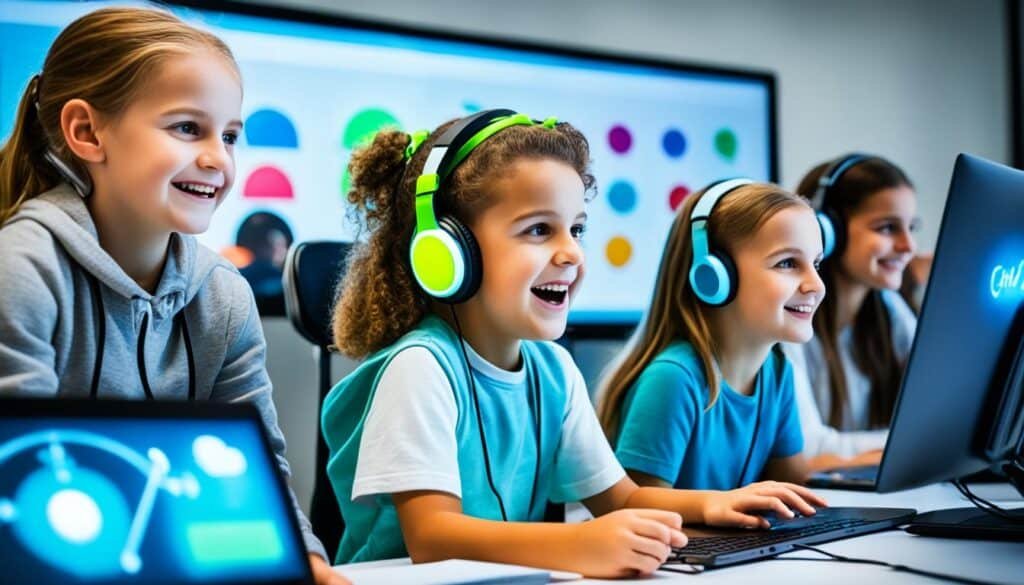
Virtual classrooms provide an online platform for students and teachers to connect and engage in real-time learning experiences. They offer a dynamic and immersive environment that replicates traditional classrooms, allowing for discussions, collaboration, and access to educational resources. Students can participate in live discussions, ask questions, and receive immediate feedback from their teachers. This real-time learning experience fosters active engagement, encourages critical thinking, and promotes effective communication skills.
The virtual classroom is a dynamic and interactive space where students can interact with their peers and collaborate on projects. Group activities and discussions enable students to exchange ideas, learn from each other, and develop teamwork skills. The virtual setting also provides a safe and inclusive environment, allowing students from diverse backgrounds to participate and contribute to class discussions.
Benefits of Virtual Classrooms
Virtual classrooms offer several benefits that enhance the learning experience:
- Real-time learning: Students can engage with their teachers and peers in real-time, facilitating immediate feedback and support.
- Dynamic and immersive environment: The virtual classroom replicates the atmosphere of a physical classroom, creating an engaging learning environment.
- Discussions and collaboration: Students can actively participate in discussions, collaborate on projects, and learn from their peers.
- Access to educational resources: Virtual classrooms provide easy access to digital learning materials, online libraries, and multimedia resources.
Virtual classrooms are especially beneficial for kids who cannot attend traditional school settings due to various reasons such as geographical barriers, health conditions, or personal circumstances. This flexible learning option allows them to continue their education and stay connected with their teachers and classmates despite the challenges they may face.
Virtual classrooms offer a unique opportunity for students to engage in real-time learning, foster collaborations, and access a wealth of educational resources from the comfort of their homes. They promote active participation, critical thinking, and effective communication skills.
For parents, virtual classrooms provide the convenience of monitoring their child’s progress and involvement in class activities. They can actively participate in their child’s education by joining virtual parent-teacher meetings, discussing assignments, and supporting their child’s learning journey.
It is important to note that virtual classrooms are not a complete replacement for physical classrooms, as they lack certain aspects like face-to-face interactions and hands-on activities. However, they can complement the traditional learning experience and offer additional opportunities for students to engage in dynamic and interactive learning.
| Benefits of Virtual Classrooms | Benefits of Traditional Classrooms |
|---|---|
| Real-time interaction with teachers and peers | Face-to-face interactions and personal connections |
| Convenience and flexibility in learning | Hands-on activities and experiential learning |
| Access to a wide range of digital resources | Access to physical resources and equipment |
| Opportunity for collaboration and discussions | Immediate feedback and support from teachers |
AI-Powered Tutors for Kids

In the digital age, AI-powered tutors have revolutionized the way children learn and excel academically. These innovative platforms, such as Khanmigo, utilize advanced artificial intelligence technology to provide personalized and interactive learning experiences for kids.
One of the key advantages of AI-powered tutors is their ability to offer one-on-one tutoring, catering to the specific learning needs of each child. This personalized approach ensures that children receive targeted instruction and support, maximizing their learning potential.
Moreover, AI-powered tutors foster critical-thinking skills by engaging students in thought-provoking activities and challenges. Through interactive exercises and problem-solving tasks, children are encouraged to think independently, analyze information, and develop creative solutions.
The Benefits of AI-Powered Tutors
AI-powered tutors offer a range of benefits for young learners. First and foremost, they provide access to personalized learning experiences that adapt to each child’s unique strengths and weaknesses. This tailored approach maximizes learning outcomes and ensures that children grasp concepts effectively.
Furthermore, AI-powered tutors are available 24/7, allowing children to learn at their own pace and on their own schedule. This flexibility is especially valuable for busy students who may have extracurricular activities or other commitments.
Additionally, AI-powered tutors create an interactive and engaging learning environment. They utilize multimedia resources, interactive quizzes, and gamification elements to make the learning process fun and enjoyable for kids. This not only enhances their motivation to learn but also improves information retention.
| Benefits of AI-Powered Tutors for Kids |
|---|
| Personalized learning experiences |
| 24/7 availability |
| Interactive and engaging learning environment |
| Fosters critical-thinking skills |
With AI-powered tutors, children can receive high-quality education and individualized support anytime and anywhere. They can gain knowledge, practice skills, and build confidence in a convenient and reliable manner.
AI-powered tutors exemplify the marriage between cutting-edge technology and effective pedagogy. They harness the power of artificial intelligence to provide children with a personalized and interactive learning experience that fosters critical-thinking skills, setting them up for academic success.
Stay tuned for the next section as we delve into the importance of balancing internet use for kids and explore strategies for building digital literacy skills.
The Importance of Balancing Internet Use for Kids
Building digital skills is essential in today’s digital age, as it equips children with the necessary knowledge and abilities to navigate the online world. However, along with the benefits, online activities also expose children to various risks and potential dangers. It is crucial for parents to actively involve themselves in their children’s online experiences and provide guidance and support.
Parental involvement plays a significant role in creating a safe and positive online environment for children. By engaging in open conversations and establishing rules and boundaries, parents can help their kids understand and manage the risks associated with the internet. It is important to educate children about online privacy, cyberbullying, and the importance of responsible digital citizenship.
“As parents, it is our responsibility to educate ourselves about online risks and equip our children with the necessary skills to protect themselves.”
In addition to parental involvement, teachers also play a crucial role in teaching children how to navigate the digital world safely. Incorporating digital literacy education into the curriculum can help children develop the skills needed to identify and avoid online risks. Teachers can guide students in understanding the importance of online privacy, critical thinking, and responsible online behavior.
A collaborative effort between parents, teachers, and schools is necessary to ensure children’s online safety and the responsible use of digital technology. By working together, parents and teachers can provide the support and guidance needed for children to develop healthy online habits and make informed decisions.
Minimizing Risks and Maximizing Benefits of Online Education
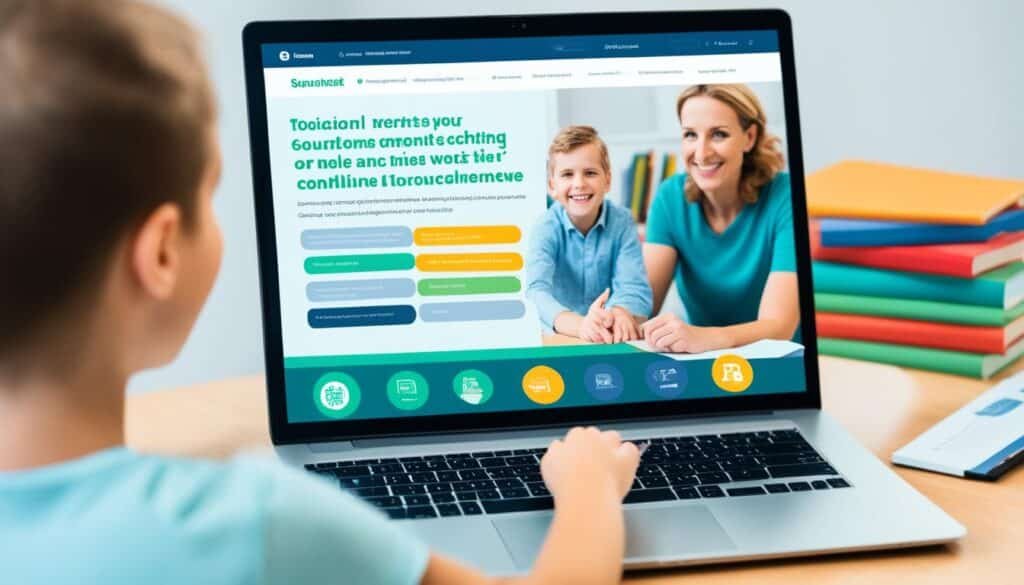
To ensure the safety and effectiveness of online education for children, it is crucial to adopt a balanced approach that minimizes risks and maximizes benefits. This requires active content monitoring by tech companies, parental involvement, and empowering teachers to guide students in using the internet responsibly. By implementing these strategies, we can create a secure and enriching digital learning environment.
Content Monitoring
Tech companies play a vital role in ensuring the safety of online education platforms. By actively monitoring and removing harmful content, they can protect children from inappropriate materials and potential dangers. This proactive approach helps create a secure learning environment that promotes positive educational experiences.
Parental Involvement
Parents are key stakeholders in their children’s online education journey. It is essential for parents to actively participate in their children’s online activities, understand the risks involved, and have open discussions about online safety. By maintaining a strong presence and providing guidance, parents can help their children navigate the digital world responsibly and make informed choices.
Empowering Teachers
Teachers play a crucial role in empowering students to use the internet safely and effectively. By receiving training and resources, teachers can confidently guide their students in making responsible online decisions and developing digital literacy skills. Empowering teachers also involves creating a supportive environment that encourages open communication about online risks and encourages collaboration with parents.
Creating a Balanced Approach
A balanced approach to online education combines the benefits of digital learning with a focus on safety. By addressing risks and providing necessary support, we can ensure that children have access to a secure and enriching learning experience. This approach involves integrating content monitoring, parental involvement, and empowering teachers, creating a comprehensive framework for online education that maximizes benefits while minimizing risks.
| Minimizing Risks | Maximizing Benefits | |
|---|---|---|
| Content Monitoring | Removal of harmful content | Safe and educational materials |
| Parental Involvement | Guidance and supervision | Support and engagement |
| Empowering Teachers | Training in online safety | Guidance in digital literacy |
By implementing a balanced approach that includes content monitoring, parental involvement, and empowering teachers, we can ensure the safety and effectiveness of online education for children. By working together, we can create an environment that maximizes the benefits of digital learning while minimizing risks.
The Role of Parents and Schools in Online Education

Parents play a key role in supporting their children’s online education by being actively involved and providing guidance. Their involvement is crucial in helping children navigate the digital landscape and develop the necessary skills to thrive in the online learning environment.
First and foremost, parents can provide support and encouragement to their children, creating a positive learning environment at home. By expressing interest and showing enthusiasm for their children’s online education, parents can instill a sense of importance and motivate them to excel.
“Parental involvement is essential in promoting students’ academic success and well-being.”
Research shows that parental involvement positively correlates with academic achievement. When parents take an active interest in their children’s education, students are more likely to perform better academically, have higher self-esteem, and exhibit positive attitudes towards learning.
In addition to providing emotional support, parents can also actively participate in their children’s online education by engaging in meaningful discussions and monitoring their progress. Regularly communicating with teachers and staying informed about their children’s activities and assignments allows parents to identify areas where additional support may be needed.
Schools also have a crucial role to play in online education. They should provide resources, training, and guidance to both parents and teachers to ensure a seamless online learning experience.
Schools can organize workshops and training sessions to enhance parents’ digital literacy skills. These sessions can educate parents about the various tools and platforms used in online education, enabling them to actively participate and provide necessary guidance to their children.
Furthermore, schools should empower teachers to effectively utilize technology and digital resources in their teaching practices. Professional development programs can help teachers enhance their digital literacy skills and incorporate innovative teaching methods that promote active engagement and collaboration among students.
Parental Involvement in Online Education
| Benefits of Parental Involvement | Actions for Parents |
|---|---|
| Improved academic performance | Engage in discussions about online lessons and assignments |
| Enhanced motivation and self-esteem | Provide support and encouragement |
| Positive attitudes towards learning | Monitor progress and communicate with teachers |
| Increased accountability and responsibility | Establish routines and set goals |
By fostering a strong partnership between parents and schools, children can receive the necessary support, guidance, and digital literacy skills to thrive in the online education landscape.
In the next section, we will explore the importance of digital literacy skills and how they can empower children to navigate the online world safely and responsibly.
Conclusion
Online education for kids provides numerous benefits, such as creating effective learning experiences, maximizing educational opportunities, and enhancing accessibility. However, it is essential to minimize the associated risks and ensure parental and teacher involvement in order to ensure the safety and success of children’s online education.
Creating effective online learning experiences involves understanding children’s unique learning styles and incorporating interactive and engaging elements. By adapting content to cater to these styles, online education can become more personalized and impactful.
Parents and teachers play a crucial role in supporting children’s online education. Parental involvement is vital in monitoring their children’s online activities, providing guidance, and fostering a safe and structured learning environment. Similarly, teachers can offer valuable insights, instruction, and support to help children navigate the online learning landscape effectively.
Ultimately, striking a balance between the benefits and risks of online education is key. By embracing technology and ensuring parental and teacher involvement, online education can provide children with valuable educational opportunities while minimizing potential risks, thus maximizing its potential for a successful and enriching learning experience.
Also Refer : How Education Is Evolving For The Future Of Work
FAQs
What is eLearning?
eLearning refers to any learning that takes place online. It allows children to learn at their own pace and provides flexibility in terms of where and when they learn. Online education enables personalized learning experiences and helps children develop digital skills.
What are the benefits of eLearning for kids?
Online education for kids is cost-effective as it eliminates the need for additional resources and can be used anywhere at any time. It saves time and offers flexibility for children with busy schedules. Online education is accessible to children from any location with an internet connection, making it a convenient option for working parents.
How can we create effective online learning experiences for kids?
Understanding children’s learning styles is important for designing effective online courses. The use of visuals, interactive content, and videos can enhance the learning experience. Easy navigation and engaging activities make the online course more enjoyable for kids. Setting specific goals helps track progress and motivates children to continue learning.
Are there personalized learning platforms available for kids?
Yes, there are personalized learning platforms that cater to individual needs and preferences, offering customized learning experiences and adaptive content. These platforms empower children to take control of their education and make the learning process engaging and effective.
What is video-based tutoring for kids?
Video-based tutoring provides personalized instruction and guidance to children through video technology. It offers flexible scheduling and eliminates geographical barriers, making it a convenient and reliable option for learners of all ages.
What are virtual classrooms for kids?
Virtual classrooms provide an online platform for students and teachers to connect and engage in real-time learning experiences. They offer a dynamic and immersive environment that replicates traditional classrooms, allowing for discussions, collaboration, and access to educational resources.
Are there AI-powered tutors for kids?
Yes, AI-powered tutors, such as Khanmigo, use advanced artificial intelligence technology to provide personalized and interactive learning experiences. They offer one-on-one tutoring and focus on fostering critical-thinking skills.
How should we balance internet use for kids?
Internet use plays a crucial role in building children’s digital skills, but it also exposes them to various risks. It’s important for parents to provide guidance and support, engaging positively in their children’s online experiences. Teachers also have a role in teaching children how to navigate the digital world safely and responsibly.
How can we minimize risks and maximize benefits of online education?
To minimize risks and maximize benefits, tech companies should actively monitor and remove harmful content. Parents should be actively involved in their children’s online activities and have discussions about online risks. Teachers should be empowered and trained to guide students in using the internet responsibly. A balanced approach is needed to ensure children’s safety and maximize the benefits of online education.
What is the role of parents and schools in online education?
Parents play a key role in supporting their children’s online education by being actively involved and providing guidance. Schools should offer opportunities for teachers to teach digital literacy skills and guide students in using the internet effectively and safely.
How can we create effective online learning experiences for kids?
Online education for kids offers numerous benefits but also comes with risks. Creating effective online learning experiences involves understanding children’s learning styles and incorporating interactive and engaging elements. Parents and teachers play a crucial role in supporting children’s online education and ensuring their safety. Balancing risks and benefits is key to maximizing the potential of online education for kids.

